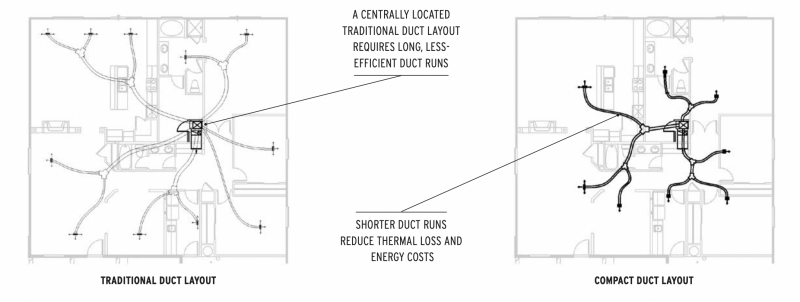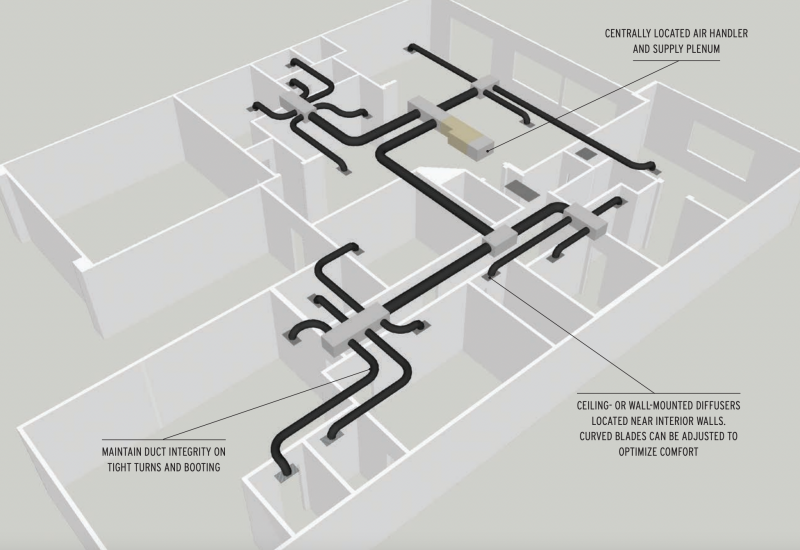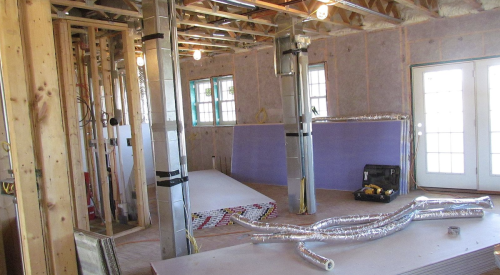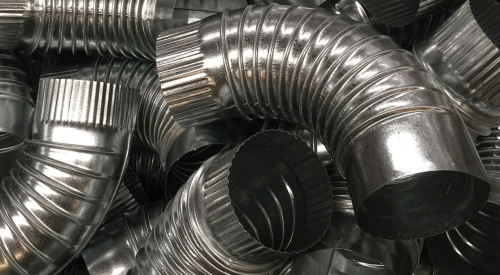Conventional duct layouts place HVAC supply registers near exterior walls because those locations used to make sense: Homes of the past were poorly insulated and drafty, causing interior surfaces of perimeter walls to get cold in winter and hot in summer; blowing conditioned air across them evened out room temperatures and diluted those drafts.
With that, most conventional forced-air systems place the air handler in the attic— a location that requires long duct runs to reach the room registers at the edges of the floor plan. The result: lots of exposed ductwork in unconditioned attics, which increases thermal loss through pressure differences and duct leaks and forces the system to work harder to maintain setpoint temperatures.
But building is different today. Energy and building codes now require a high level of insulation, high-performance glazing, and better air sealing, so the temperature of perimeter walls doesn’t fluctuate nearly as much as it used to.

The Case for Compact Layouts
That’s why some builders have switched to compact duct layouts. To deliver supply air more efficiently, such designs place the air handling unit (AHU) in conditioned space near the center of the home. Multiple plenums placed throughout the floor plan enable fewer, and shorter, duct runs from the AHU to diffusers in the ceiling or high on the wall of each room or area (see diagrams, opposite page).
Reducing duct material and installation labor by not running ducts to the exterior walls means compact layouts save builders money on every house.
Some builders still worry that they must wash exterior walls with conditioned air, but today’s windows and code-mandated envelope details really do eliminate that need. In fact, the production builders we have helped to implement this approach report fewer indoor comfort complaints from homeowners.

Attention to Detail
There are two caveats when it comes to compact duct layouts, but they’re neither complicated nor difficult.
The first is that installers must be careful not to kink ducts during installation (which they shouldn’t do, regardless). Kinking is less of a concern with long, conventional runs that can be gently arched, but shorter runs tend to create tighter turns that may make them more likely to get pinched around framing members or when entering a boot connection.
The second is that, unlike conventional stamped registers in the ceiling or floor, you need to use ceiling- or wall-mounted diffusers, which have directional fins designed to serve larger areas. We recommend diffusers with curved blades, so that air is evenly spread across the ceiling and then gradually falls into the room. Once the system is on, the installer can adjust the diffusers for optimal comfort.
Note that diffusers cannot be placed on the floor. That’s not an issue with slabon-grade homes, but if the plenum runs through a basement or crawlspace, then diffusers must be located high on interior walls.
Diffusing Resistance
As for implementation, we find it takes the typical production builder about a year to redesign the ductwork in all of its floor plans and to work out any issues associated with installation quality. An alternative is to use compact layouts only on new plans going forward.
Also, while a compact layout takes less time to install, some builders are skeptical about getting HVAC subcontractors to embrace it. The builders we know that have experienced success started with just a few homes, and then, once their trades saw that it made their life easier and reduced callbacks, they readily jumped on board.
Tim Kampert drives quality and performance in home building as a building performance specialist for the PERFORM Builder Solutions team at IBACOS.
This story first ran as part of IBACOS and Pro Builder's joint "Quality Matters" column













